Analysis of Quality Management Strategies for IHG Report
VerifiedAdded on 2021/01/01
|13
|4242
|331
Report
AI Summary
This report provides a comprehensive analysis of quality management principles and practices within the Inter-Continental Hotel Group (IHG), a major player in the hospitality industry. It begins by defining quality in a business context, emphasizing its importance in meeting customer needs and satisfaction. The report then delves into quality assurance and inspection processes, outlining the standards and audits employed by IHG to maintain service effectiveness. It explores various quality management approaches, including those of W. Edwards Deming and Joseph Juran, highlighting their similarities and differences. The report further examines customer satisfaction and continuous improvement, emphasizing their role in enhancing customer base and competitive image. It also identifies the value added through quality provision, such as personalized customer service and cost reduction, and describes different types of information made available to customers for effective marketing. The report concludes by discussing methods for measuring quality, including competitor comparisons and compliance with industry standards, and explores the benefits of using surveys. Additionally, the report covers methods of consultation, the value of complaints procedures, and the role of self-assessment in improving service quality.

QUALITY
MANAGEMENT IN
BUSINESS
MANAGEMENT IN
BUSINESS
Paraphrase This Document
Need a fresh take? Get an instant paraphrase of this document with our AI Paraphraser
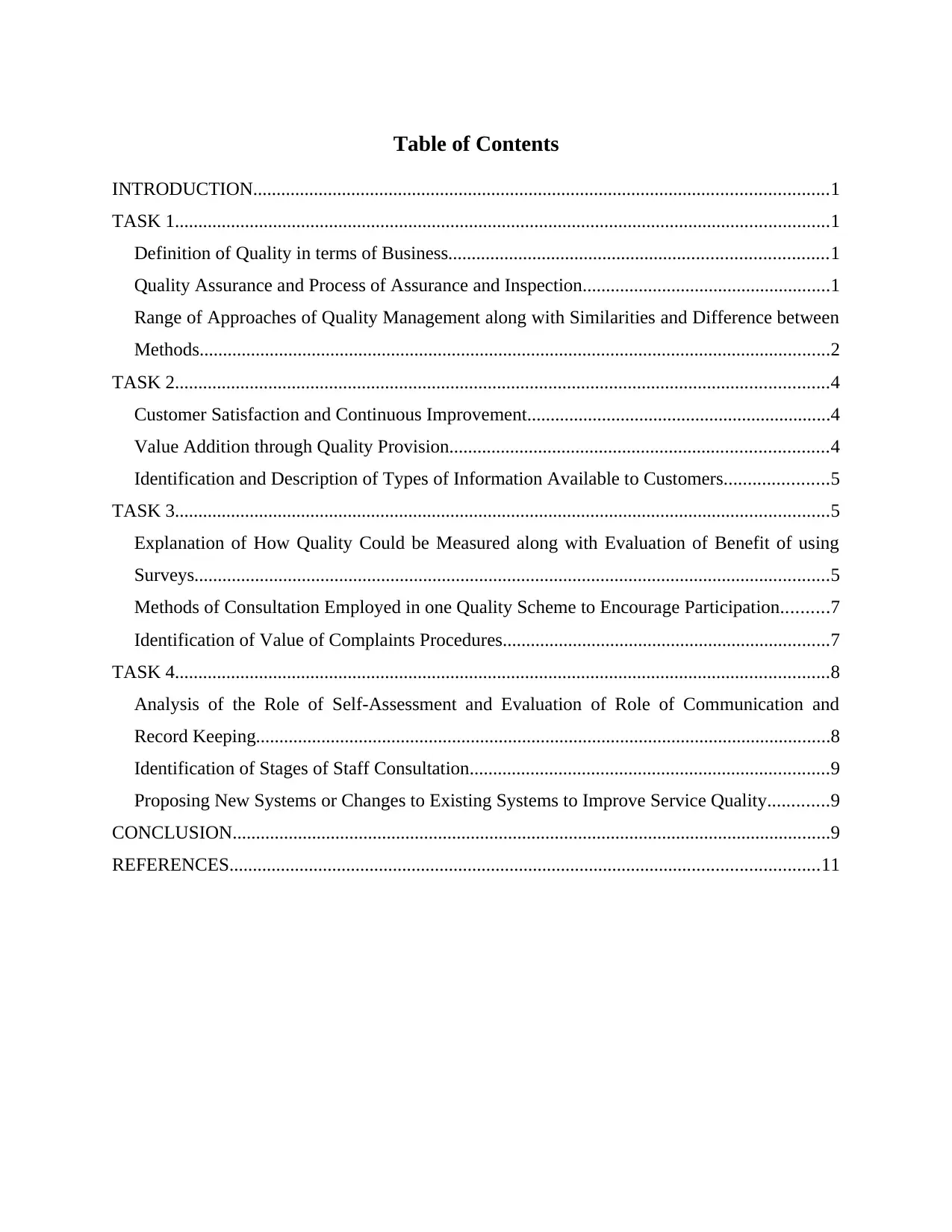
Table of Contents
INTRODUCTION...........................................................................................................................1
TASK 1............................................................................................................................................1
Definition of Quality in terms of Business.................................................................................1
Quality Assurance and Process of Assurance and Inspection.....................................................1
Range of Approaches of Quality Management along with Similarities and Difference between
Methods.......................................................................................................................................2
TASK 2............................................................................................................................................4
Customer Satisfaction and Continuous Improvement.................................................................4
Value Addition through Quality Provision.................................................................................4
Identification and Description of Types of Information Available to Customers......................5
TASK 3............................................................................................................................................5
Explanation of How Quality Could be Measured along with Evaluation of Benefit of using
Surveys........................................................................................................................................5
Methods of Consultation Employed in one Quality Scheme to Encourage Participation..........7
Identification of Value of Complaints Procedures......................................................................7
TASK 4............................................................................................................................................8
Analysis of the Role of Self-Assessment and Evaluation of Role of Communication and
Record Keeping...........................................................................................................................8
Identification of Stages of Staff Consultation.............................................................................9
Proposing New Systems or Changes to Existing Systems to Improve Service Quality.............9
CONCLUSION................................................................................................................................9
REFERENCES..............................................................................................................................11
INTRODUCTION...........................................................................................................................1
TASK 1............................................................................................................................................1
Definition of Quality in terms of Business.................................................................................1
Quality Assurance and Process of Assurance and Inspection.....................................................1
Range of Approaches of Quality Management along with Similarities and Difference between
Methods.......................................................................................................................................2
TASK 2............................................................................................................................................4
Customer Satisfaction and Continuous Improvement.................................................................4
Value Addition through Quality Provision.................................................................................4
Identification and Description of Types of Information Available to Customers......................5
TASK 3............................................................................................................................................5
Explanation of How Quality Could be Measured along with Evaluation of Benefit of using
Surveys........................................................................................................................................5
Methods of Consultation Employed in one Quality Scheme to Encourage Participation..........7
Identification of Value of Complaints Procedures......................................................................7
TASK 4............................................................................................................................................8
Analysis of the Role of Self-Assessment and Evaluation of Role of Communication and
Record Keeping...........................................................................................................................8
Identification of Stages of Staff Consultation.............................................................................9
Proposing New Systems or Changes to Existing Systems to Improve Service Quality.............9
CONCLUSION................................................................................................................................9
REFERENCES..............................................................................................................................11
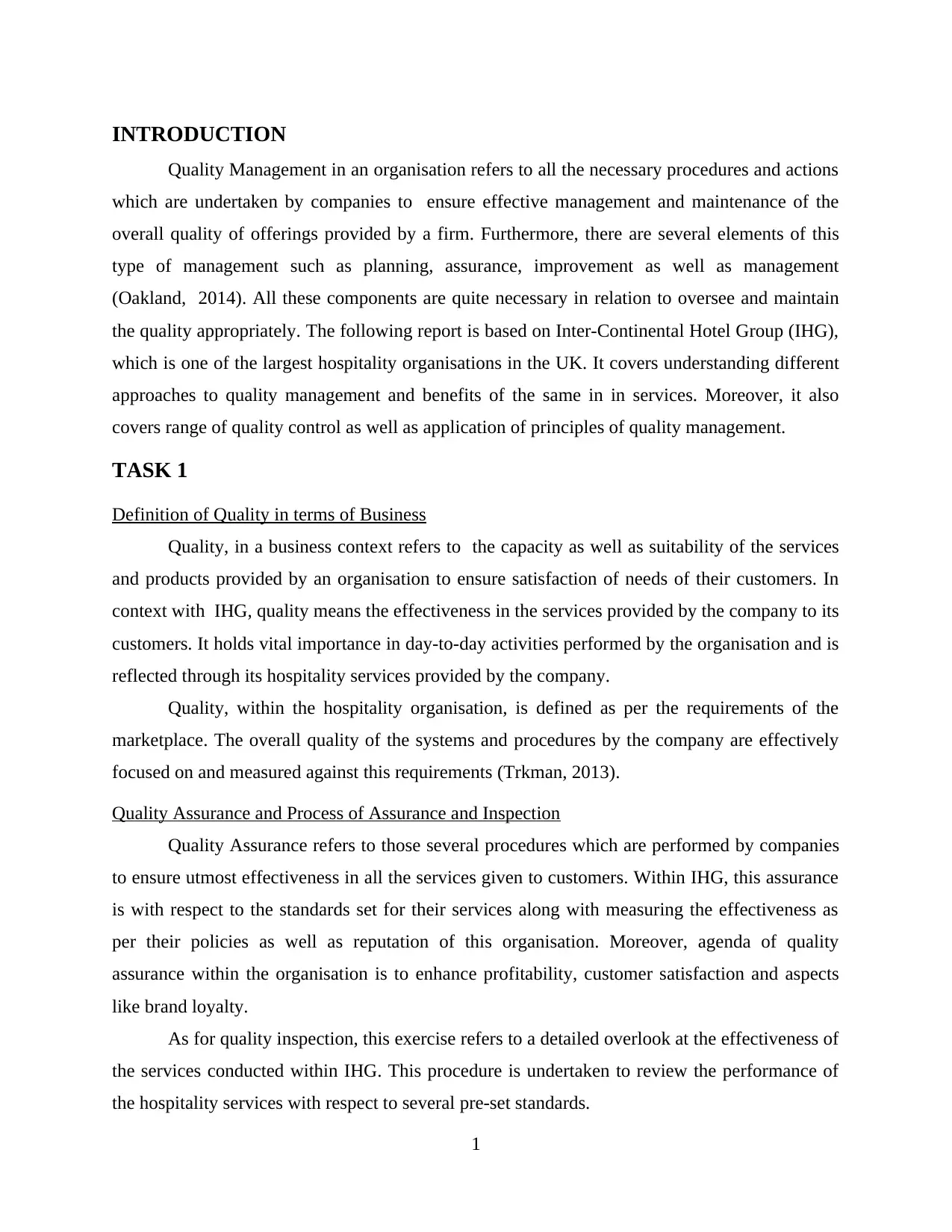
INTRODUCTION
Quality Management in an organisation refers to all the necessary procedures and actions
which are undertaken by companies to ensure effective management and maintenance of the
overall quality of offerings provided by a firm. Furthermore, there are several elements of this
type of management such as planning, assurance, improvement as well as management
(Oakland, 2014). All these components are quite necessary in relation to oversee and maintain
the quality appropriately. The following report is based on Inter-Continental Hotel Group (IHG),
which is one of the largest hospitality organisations in the UK. It covers understanding different
approaches to quality management and benefits of the same in in services. Moreover, it also
covers range of quality control as well as application of principles of quality management.
TASK 1
Definition of Quality in terms of Business
Quality, in a business context refers to the capacity as well as suitability of the services
and products provided by an organisation to ensure satisfaction of needs of their customers. In
context with IHG, quality means the effectiveness in the services provided by the company to its
customers. It holds vital importance in day-to-day activities performed by the organisation and is
reflected through its hospitality services provided by the company.
Quality, within the hospitality organisation, is defined as per the requirements of the
marketplace. The overall quality of the systems and procedures by the company are effectively
focused on and measured against this requirements (Trkman, 2013).
Quality Assurance and Process of Assurance and Inspection
Quality Assurance refers to those several procedures which are performed by companies
to ensure utmost effectiveness in all the services given to customers. Within IHG, this assurance
is with respect to the standards set for their services along with measuring the effectiveness as
per their policies as well as reputation of this organisation. Moreover, agenda of quality
assurance within the organisation is to enhance profitability, customer satisfaction and aspects
like brand loyalty.
As for quality inspection, this exercise refers to a detailed overlook at the effectiveness of
the services conducted within IHG. This procedure is undertaken to review the performance of
the hospitality services with respect to several pre-set standards.
1
Quality Management in an organisation refers to all the necessary procedures and actions
which are undertaken by companies to ensure effective management and maintenance of the
overall quality of offerings provided by a firm. Furthermore, there are several elements of this
type of management such as planning, assurance, improvement as well as management
(Oakland, 2014). All these components are quite necessary in relation to oversee and maintain
the quality appropriately. The following report is based on Inter-Continental Hotel Group (IHG),
which is one of the largest hospitality organisations in the UK. It covers understanding different
approaches to quality management and benefits of the same in in services. Moreover, it also
covers range of quality control as well as application of principles of quality management.
TASK 1
Definition of Quality in terms of Business
Quality, in a business context refers to the capacity as well as suitability of the services
and products provided by an organisation to ensure satisfaction of needs of their customers. In
context with IHG, quality means the effectiveness in the services provided by the company to its
customers. It holds vital importance in day-to-day activities performed by the organisation and is
reflected through its hospitality services provided by the company.
Quality, within the hospitality organisation, is defined as per the requirements of the
marketplace. The overall quality of the systems and procedures by the company are effectively
focused on and measured against this requirements (Trkman, 2013).
Quality Assurance and Process of Assurance and Inspection
Quality Assurance refers to those several procedures which are performed by companies
to ensure utmost effectiveness in all the services given to customers. Within IHG, this assurance
is with respect to the standards set for their services along with measuring the effectiveness as
per their policies as well as reputation of this organisation. Moreover, agenda of quality
assurance within the organisation is to enhance profitability, customer satisfaction and aspects
like brand loyalty.
As for quality inspection, this exercise refers to a detailed overlook at the effectiveness of
the services conducted within IHG. This procedure is undertaken to review the performance of
the hospitality services with respect to several pre-set standards.
1
⊘ This is a preview!⊘
Do you want full access?
Subscribe today to unlock all pages.

Trusted by 1+ million students worldwide
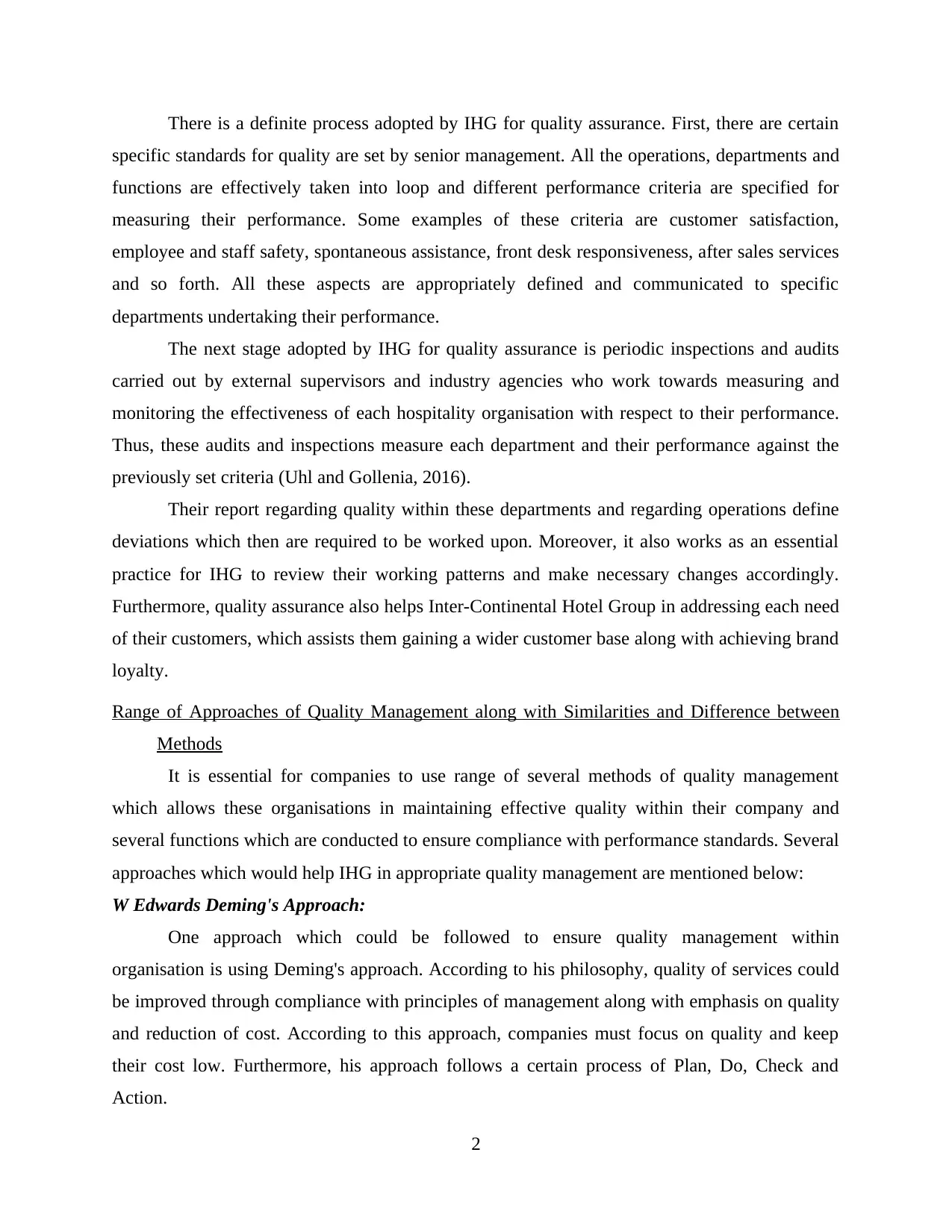
There is a definite process adopted by IHG for quality assurance. First, there are certain
specific standards for quality are set by senior management. All the operations, departments and
functions are effectively taken into loop and different performance criteria are specified for
measuring their performance. Some examples of these criteria are customer satisfaction,
employee and staff safety, spontaneous assistance, front desk responsiveness, after sales services
and so forth. All these aspects are appropriately defined and communicated to specific
departments undertaking their performance.
The next stage adopted by IHG for quality assurance is periodic inspections and audits
carried out by external supervisors and industry agencies who work towards measuring and
monitoring the effectiveness of each hospitality organisation with respect to their performance.
Thus, these audits and inspections measure each department and their performance against the
previously set criteria (Uhl and Gollenia, 2016).
Their report regarding quality within these departments and regarding operations define
deviations which then are required to be worked upon. Moreover, it also works as an essential
practice for IHG to review their working patterns and make necessary changes accordingly.
Furthermore, quality assurance also helps Inter-Continental Hotel Group in addressing each need
of their customers, which assists them gaining a wider customer base along with achieving brand
loyalty.
Range of Approaches of Quality Management along with Similarities and Difference between
Methods
It is essential for companies to use range of several methods of quality management
which allows these organisations in maintaining effective quality within their company and
several functions which are conducted to ensure compliance with performance standards. Several
approaches which would help IHG in appropriate quality management are mentioned below:
W Edwards Deming's Approach:
One approach which could be followed to ensure quality management within
organisation is using Deming's approach. According to his philosophy, quality of services could
be improved through compliance with principles of management along with emphasis on quality
and reduction of cost. According to this approach, companies must focus on quality and keep
their cost low. Furthermore, his approach follows a certain process of Plan, Do, Check and
Action.
2
specific standards for quality are set by senior management. All the operations, departments and
functions are effectively taken into loop and different performance criteria are specified for
measuring their performance. Some examples of these criteria are customer satisfaction,
employee and staff safety, spontaneous assistance, front desk responsiveness, after sales services
and so forth. All these aspects are appropriately defined and communicated to specific
departments undertaking their performance.
The next stage adopted by IHG for quality assurance is periodic inspections and audits
carried out by external supervisors and industry agencies who work towards measuring and
monitoring the effectiveness of each hospitality organisation with respect to their performance.
Thus, these audits and inspections measure each department and their performance against the
previously set criteria (Uhl and Gollenia, 2016).
Their report regarding quality within these departments and regarding operations define
deviations which then are required to be worked upon. Moreover, it also works as an essential
practice for IHG to review their working patterns and make necessary changes accordingly.
Furthermore, quality assurance also helps Inter-Continental Hotel Group in addressing each need
of their customers, which assists them gaining a wider customer base along with achieving brand
loyalty.
Range of Approaches of Quality Management along with Similarities and Difference between
Methods
It is essential for companies to use range of several methods of quality management
which allows these organisations in maintaining effective quality within their company and
several functions which are conducted to ensure compliance with performance standards. Several
approaches which would help IHG in appropriate quality management are mentioned below:
W Edwards Deming's Approach:
One approach which could be followed to ensure quality management within
organisation is using Deming's approach. According to his philosophy, quality of services could
be improved through compliance with principles of management along with emphasis on quality
and reduction of cost. According to this approach, companies must focus on quality and keep
their cost low. Furthermore, his approach follows a certain process of Plan, Do, Check and
Action.
2
Paraphrase This Document
Need a fresh take? Get an instant paraphrase of this document with our AI Paraphraser
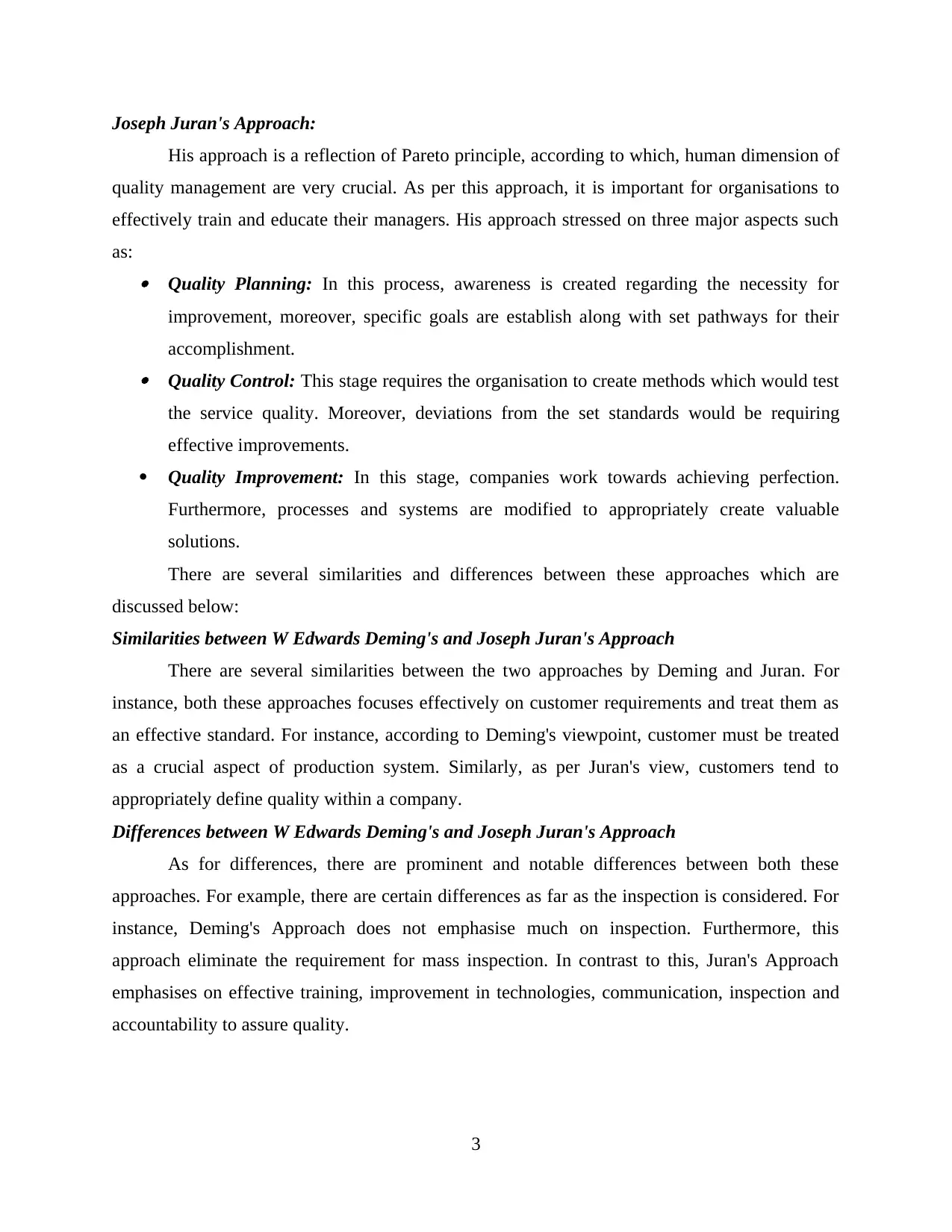
Joseph Juran's Approach:
His approach is a reflection of Pareto principle, according to which, human dimension of
quality management are very crucial. As per this approach, it is important for organisations to
effectively train and educate their managers. His approach stressed on three major aspects such
as: Quality Planning: In this process, awareness is created regarding the necessity for
improvement, moreover, specific goals are establish along with set pathways for their
accomplishment. Quality Control: This stage requires the organisation to create methods which would test
the service quality. Moreover, deviations from the set standards would be requiring
effective improvements.
Quality Improvement: In this stage, companies work towards achieving perfection.
Furthermore, processes and systems are modified to appropriately create valuable
solutions.
There are several similarities and differences between these approaches which are
discussed below:
Similarities between W Edwards Deming's and Joseph Juran's Approach
There are several similarities between the two approaches by Deming and Juran. For
instance, both these approaches focuses effectively on customer requirements and treat them as
an effective standard. For instance, according to Deming's viewpoint, customer must be treated
as a crucial aspect of production system. Similarly, as per Juran's view, customers tend to
appropriately define quality within a company.
Differences between W Edwards Deming's and Joseph Juran's Approach
As for differences, there are prominent and notable differences between both these
approaches. For example, there are certain differences as far as the inspection is considered. For
instance, Deming's Approach does not emphasise much on inspection. Furthermore, this
approach eliminate the requirement for mass inspection. In contrast to this, Juran's Approach
emphasises on effective training, improvement in technologies, communication, inspection and
accountability to assure quality.
3
His approach is a reflection of Pareto principle, according to which, human dimension of
quality management are very crucial. As per this approach, it is important for organisations to
effectively train and educate their managers. His approach stressed on three major aspects such
as: Quality Planning: In this process, awareness is created regarding the necessity for
improvement, moreover, specific goals are establish along with set pathways for their
accomplishment. Quality Control: This stage requires the organisation to create methods which would test
the service quality. Moreover, deviations from the set standards would be requiring
effective improvements.
Quality Improvement: In this stage, companies work towards achieving perfection.
Furthermore, processes and systems are modified to appropriately create valuable
solutions.
There are several similarities and differences between these approaches which are
discussed below:
Similarities between W Edwards Deming's and Joseph Juran's Approach
There are several similarities between the two approaches by Deming and Juran. For
instance, both these approaches focuses effectively on customer requirements and treat them as
an effective standard. For instance, according to Deming's viewpoint, customer must be treated
as a crucial aspect of production system. Similarly, as per Juran's view, customers tend to
appropriately define quality within a company.
Differences between W Edwards Deming's and Joseph Juran's Approach
As for differences, there are prominent and notable differences between both these
approaches. For example, there are certain differences as far as the inspection is considered. For
instance, Deming's Approach does not emphasise much on inspection. Furthermore, this
approach eliminate the requirement for mass inspection. In contrast to this, Juran's Approach
emphasises on effective training, improvement in technologies, communication, inspection and
accountability to assure quality.
3

TASK 2
Customer Satisfaction and Continuous Improvement
Customer Satisfaction means an effective accomplishment of the needs and requirements
of the customers within an organisation. It is essential for each organisation to work towards
keeping their service users happy and satisfied. In context with IHG, this could refer to
measuring the effectiveness of their hospitality services against the need and demands as per
their service users (Zimon, 2015). Furthermore, high customer satisfaction within IHG would
ensure expansion in its customer base along with gaining a competitive image in the market. In
addition to this, it would encourage them to keep up with their consistency in acquiring services
of the company. In context with the organisation, there are several approaches applied by the
firm to ensure customer satisfaction. One such approach is the relationship manager hired by the
firm with respect to addressing the problems and requirements of each customer acquiring
services of the firm.
As for continuous improvement, it is a process which ensures constant growth and
development within organisational functions and operations. Furthermore, this aspect contains
appropriate and relevant steps which are crucial and necessary for organisation to ensure
compliance with set standards and continuous growth in their operations. As for IHG, continuous
improvement would help the firm in effectively enhancing its competence and continuously
improving the efficiency in their functions and working. There are several ways in which
continuous improvement could be achieved. For instance, the firm could identify areas which
require improvement in its operations. Along with this, they could plan and certain processes
which works towards improving these processes. Continuous improvement could be applied on
each area of the company, such as customer service, food quality, safety, etc.
Value Addition through Quality Provision
Quality in provision of services within an organisation results in ensuring added value
while creating customer service within the company. Quality in service provision must be an
essential aspect of continuous improvement and provides several benefits to organisations. In
context of IHG, the company uses latest technologies and databases which allows them to give
personalised customer service to their service users. Furthermore, training and development
systems are reviewed as well as modified in relation to enhance their competence and
4
Customer Satisfaction and Continuous Improvement
Customer Satisfaction means an effective accomplishment of the needs and requirements
of the customers within an organisation. It is essential for each organisation to work towards
keeping their service users happy and satisfied. In context with IHG, this could refer to
measuring the effectiveness of their hospitality services against the need and demands as per
their service users (Zimon, 2015). Furthermore, high customer satisfaction within IHG would
ensure expansion in its customer base along with gaining a competitive image in the market. In
addition to this, it would encourage them to keep up with their consistency in acquiring services
of the company. In context with the organisation, there are several approaches applied by the
firm to ensure customer satisfaction. One such approach is the relationship manager hired by the
firm with respect to addressing the problems and requirements of each customer acquiring
services of the firm.
As for continuous improvement, it is a process which ensures constant growth and
development within organisational functions and operations. Furthermore, this aspect contains
appropriate and relevant steps which are crucial and necessary for organisation to ensure
compliance with set standards and continuous growth in their operations. As for IHG, continuous
improvement would help the firm in effectively enhancing its competence and continuously
improving the efficiency in their functions and working. There are several ways in which
continuous improvement could be achieved. For instance, the firm could identify areas which
require improvement in its operations. Along with this, they could plan and certain processes
which works towards improving these processes. Continuous improvement could be applied on
each area of the company, such as customer service, food quality, safety, etc.
Value Addition through Quality Provision
Quality in provision of services within an organisation results in ensuring added value
while creating customer service within the company. Quality in service provision must be an
essential aspect of continuous improvement and provides several benefits to organisations. In
context of IHG, the company uses latest technologies and databases which allows them to give
personalised customer service to their service users. Furthermore, training and development
systems are reviewed as well as modified in relation to enhance their competence and
4
⊘ This is a preview!⊘
Do you want full access?
Subscribe today to unlock all pages.

Trusted by 1+ million students worldwide
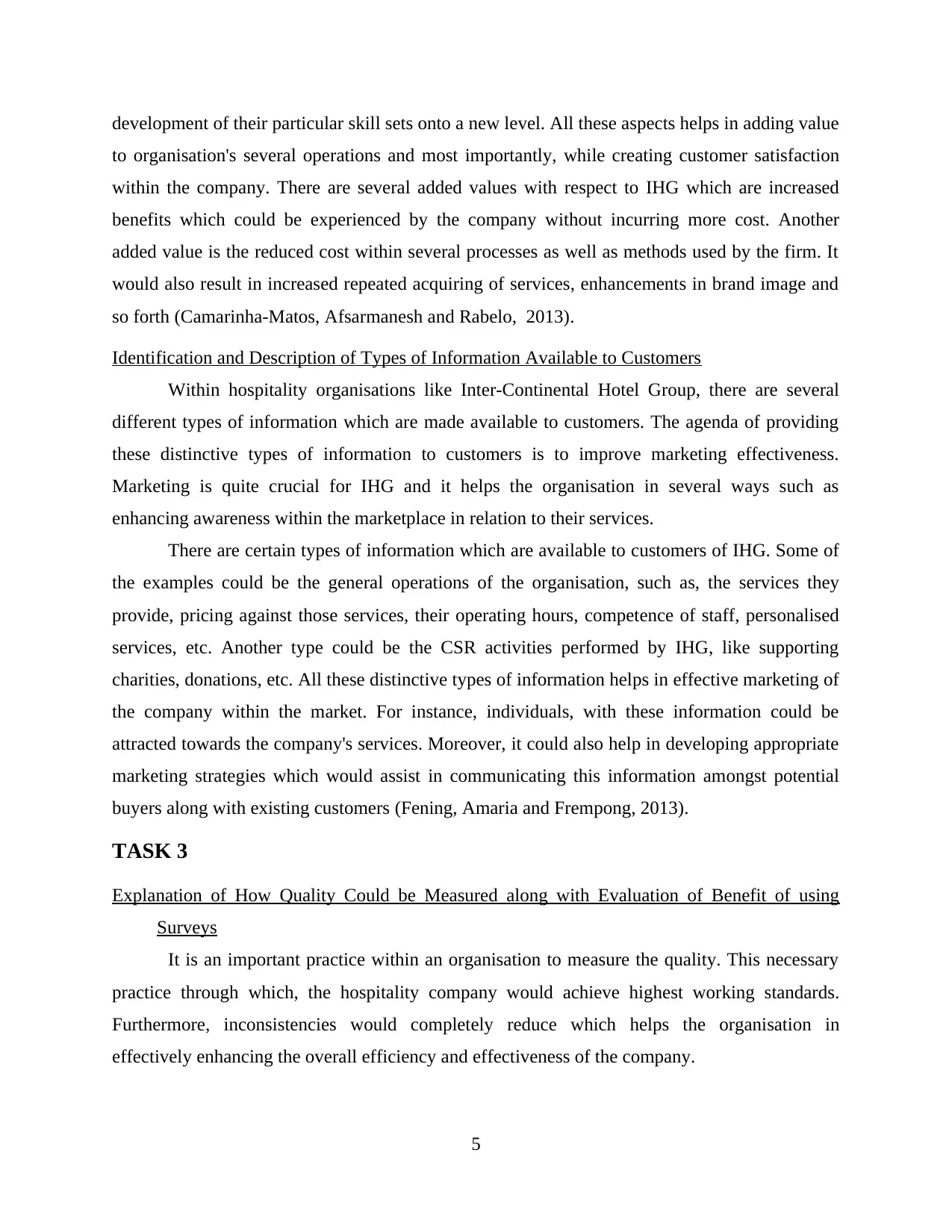
development of their particular skill sets onto a new level. All these aspects helps in adding value
to organisation's several operations and most importantly, while creating customer satisfaction
within the company. There are several added values with respect to IHG which are increased
benefits which could be experienced by the company without incurring more cost. Another
added value is the reduced cost within several processes as well as methods used by the firm. It
would also result in increased repeated acquiring of services, enhancements in brand image and
so forth (Camarinha-Matos, Afsarmanesh and Rabelo, 2013).
Identification and Description of Types of Information Available to Customers
Within hospitality organisations like Inter-Continental Hotel Group, there are several
different types of information which are made available to customers. The agenda of providing
these distinctive types of information to customers is to improve marketing effectiveness.
Marketing is quite crucial for IHG and it helps the organisation in several ways such as
enhancing awareness within the marketplace in relation to their services.
There are certain types of information which are available to customers of IHG. Some of
the examples could be the general operations of the organisation, such as, the services they
provide, pricing against those services, their operating hours, competence of staff, personalised
services, etc. Another type could be the CSR activities performed by IHG, like supporting
charities, donations, etc. All these distinctive types of information helps in effective marketing of
the company within the market. For instance, individuals, with these information could be
attracted towards the company's services. Moreover, it could also help in developing appropriate
marketing strategies which would assist in communicating this information amongst potential
buyers along with existing customers (Fening, Amaria and Frempong, 2013).
TASK 3
Explanation of How Quality Could be Measured along with Evaluation of Benefit of using
Surveys
It is an important practice within an organisation to measure the quality. This necessary
practice through which, the hospitality company would achieve highest working standards.
Furthermore, inconsistencies would completely reduce which helps the organisation in
effectively enhancing the overall efficiency and effectiveness of the company.
5
to organisation's several operations and most importantly, while creating customer satisfaction
within the company. There are several added values with respect to IHG which are increased
benefits which could be experienced by the company without incurring more cost. Another
added value is the reduced cost within several processes as well as methods used by the firm. It
would also result in increased repeated acquiring of services, enhancements in brand image and
so forth (Camarinha-Matos, Afsarmanesh and Rabelo, 2013).
Identification and Description of Types of Information Available to Customers
Within hospitality organisations like Inter-Continental Hotel Group, there are several
different types of information which are made available to customers. The agenda of providing
these distinctive types of information to customers is to improve marketing effectiveness.
Marketing is quite crucial for IHG and it helps the organisation in several ways such as
enhancing awareness within the marketplace in relation to their services.
There are certain types of information which are available to customers of IHG. Some of
the examples could be the general operations of the organisation, such as, the services they
provide, pricing against those services, their operating hours, competence of staff, personalised
services, etc. Another type could be the CSR activities performed by IHG, like supporting
charities, donations, etc. All these distinctive types of information helps in effective marketing of
the company within the market. For instance, individuals, with these information could be
attracted towards the company's services. Moreover, it could also help in developing appropriate
marketing strategies which would assist in communicating this information amongst potential
buyers along with existing customers (Fening, Amaria and Frempong, 2013).
TASK 3
Explanation of How Quality Could be Measured along with Evaluation of Benefit of using
Surveys
It is an important practice within an organisation to measure the quality. This necessary
practice through which, the hospitality company would achieve highest working standards.
Furthermore, inconsistencies would completely reduce which helps the organisation in
effectively enhancing the overall efficiency and effectiveness of the company.
5
Paraphrase This Document
Need a fresh take? Get an instant paraphrase of this document with our AI Paraphraser
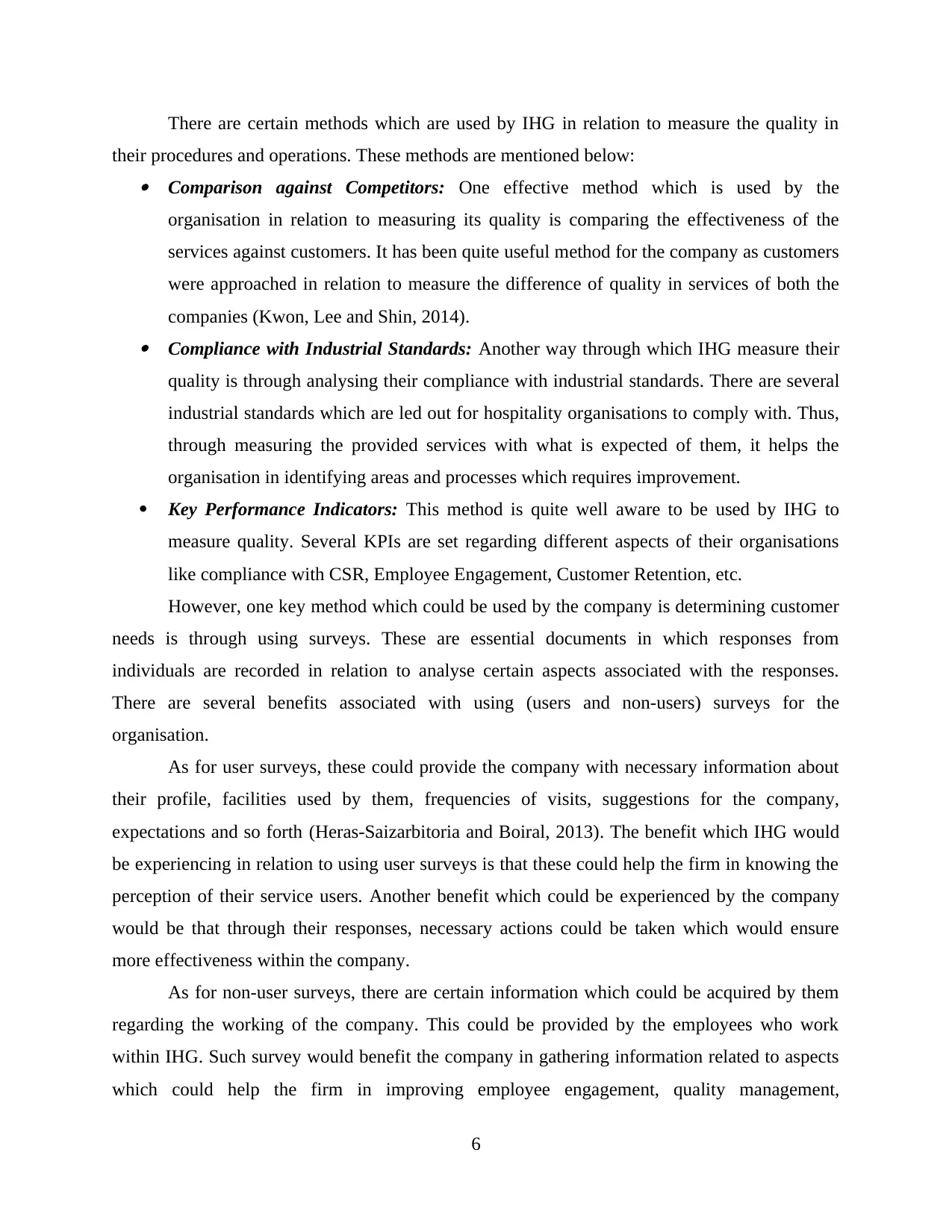
There are certain methods which are used by IHG in relation to measure the quality in
their procedures and operations. These methods are mentioned below: Comparison against Competitors: One effective method which is used by the
organisation in relation to measuring its quality is comparing the effectiveness of the
services against customers. It has been quite useful method for the company as customers
were approached in relation to measure the difference of quality in services of both the
companies (Kwon, Lee and Shin, 2014). Compliance with Industrial Standards: Another way through which IHG measure their
quality is through analysing their compliance with industrial standards. There are several
industrial standards which are led out for hospitality organisations to comply with. Thus,
through measuring the provided services with what is expected of them, it helps the
organisation in identifying areas and processes which requires improvement.
Key Performance Indicators: This method is quite well aware to be used by IHG to
measure quality. Several KPIs are set regarding different aspects of their organisations
like compliance with CSR, Employee Engagement, Customer Retention, etc.
However, one key method which could be used by the company is determining customer
needs is through using surveys. These are essential documents in which responses from
individuals are recorded in relation to analyse certain aspects associated with the responses.
There are several benefits associated with using (users and non-users) surveys for the
organisation.
As for user surveys, these could provide the company with necessary information about
their profile, facilities used by them, frequencies of visits, suggestions for the company,
expectations and so forth (Heras‐Saizarbitoria and Boiral, 2013). The benefit which IHG would
be experiencing in relation to using user surveys is that these could help the firm in knowing the
perception of their service users. Another benefit which could be experienced by the company
would be that through their responses, necessary actions could be taken which would ensure
more effectiveness within the company.
As for non-user surveys, there are certain information which could be acquired by them
regarding the working of the company. This could be provided by the employees who work
within IHG. Such survey would benefit the company in gathering information related to aspects
which could help the firm in improving employee engagement, quality management,
6
their procedures and operations. These methods are mentioned below: Comparison against Competitors: One effective method which is used by the
organisation in relation to measuring its quality is comparing the effectiveness of the
services against customers. It has been quite useful method for the company as customers
were approached in relation to measure the difference of quality in services of both the
companies (Kwon, Lee and Shin, 2014). Compliance with Industrial Standards: Another way through which IHG measure their
quality is through analysing their compliance with industrial standards. There are several
industrial standards which are led out for hospitality organisations to comply with. Thus,
through measuring the provided services with what is expected of them, it helps the
organisation in identifying areas and processes which requires improvement.
Key Performance Indicators: This method is quite well aware to be used by IHG to
measure quality. Several KPIs are set regarding different aspects of their organisations
like compliance with CSR, Employee Engagement, Customer Retention, etc.
However, one key method which could be used by the company is determining customer
needs is through using surveys. These are essential documents in which responses from
individuals are recorded in relation to analyse certain aspects associated with the responses.
There are several benefits associated with using (users and non-users) surveys for the
organisation.
As for user surveys, these could provide the company with necessary information about
their profile, facilities used by them, frequencies of visits, suggestions for the company,
expectations and so forth (Heras‐Saizarbitoria and Boiral, 2013). The benefit which IHG would
be experiencing in relation to using user surveys is that these could help the firm in knowing the
perception of their service users. Another benefit which could be experienced by the company
would be that through their responses, necessary actions could be taken which would ensure
more effectiveness within the company.
As for non-user surveys, there are certain information which could be acquired by them
regarding the working of the company. This could be provided by the employees who work
within IHG. Such survey would benefit the company in gathering information related to aspects
which could help the firm in improving employee engagement, quality management,
6

effectiveness of policies, etc. Necessary actions could be taken by the firm through these surveys
with respect to effectively achieve success (Goetsch and Davis, 2014).
Methods of Consultation Employed in one Quality Scheme to Encourage Participation
It is essential within IHG that consultation of employees are effectively acquired to
engage them further within the company. Furthermore, employee participation effectively
enhances the productivity and efficiency of an organisation. In context with Inter-Continental
Hotel Group, its quality system effectively consults with employees in relation to taking key
business decisions. However, there are several methods in this quality scheme of the company
which could be used in relation to effectively consult with under-represented groups.
The first and most basic method which could be used by the firm is questionnaires. The
company could use effective questionnaires to be provided internally within the under-
represented groups which helps in appropriately gathering crucial information from them
regarding the decisions related to quality management of the business. For instance,
questionnaires could help management in acquiring knowledge regarding the employment
schemes of the company. Another method which could be used by the company is open one-on-
one meetings and interviews which could be used by IHG in relation to gathering effective
information from these groups. The benefit from these aspects would be that the company would
ensure participation of these employees which are likely to feel demotivated due to remaining
under-represented. This would help the company in engaging them effectively and ensuring their
loyalty towards the firm (Chang, 2016).
Identification of Value of Complaints Procedures
Complaint Procedure refers to a range of processes within a company which provides
assurance to organisation with respect to compliance with ethical work frame. This procedure
makes it certain that employees would report any sort of unfair or unethical event transpired
within the company. Certain documentations are provided to employees where this procedure is
mentioned.
In context with IHG, the company follows an effective complaint procedure which helps
the senior managers in identifying problems in services or methods within the company.
Moreover, it has effective value within the company as it assists the organisation in providing
world-class services to customers and effective facilities to their employees. It could be
effectively used to improve quality in the organisation. This could be achieved as employees
7
with respect to effectively achieve success (Goetsch and Davis, 2014).
Methods of Consultation Employed in one Quality Scheme to Encourage Participation
It is essential within IHG that consultation of employees are effectively acquired to
engage them further within the company. Furthermore, employee participation effectively
enhances the productivity and efficiency of an organisation. In context with Inter-Continental
Hotel Group, its quality system effectively consults with employees in relation to taking key
business decisions. However, there are several methods in this quality scheme of the company
which could be used in relation to effectively consult with under-represented groups.
The first and most basic method which could be used by the firm is questionnaires. The
company could use effective questionnaires to be provided internally within the under-
represented groups which helps in appropriately gathering crucial information from them
regarding the decisions related to quality management of the business. For instance,
questionnaires could help management in acquiring knowledge regarding the employment
schemes of the company. Another method which could be used by the company is open one-on-
one meetings and interviews which could be used by IHG in relation to gathering effective
information from these groups. The benefit from these aspects would be that the company would
ensure participation of these employees which are likely to feel demotivated due to remaining
under-represented. This would help the company in engaging them effectively and ensuring their
loyalty towards the firm (Chang, 2016).
Identification of Value of Complaints Procedures
Complaint Procedure refers to a range of processes within a company which provides
assurance to organisation with respect to compliance with ethical work frame. This procedure
makes it certain that employees would report any sort of unfair or unethical event transpired
within the company. Certain documentations are provided to employees where this procedure is
mentioned.
In context with IHG, the company follows an effective complaint procedure which helps
the senior managers in identifying problems in services or methods within the company.
Moreover, it has effective value within the company as it assists the organisation in providing
world-class services to customers and effective facilities to their employees. It could be
effectively used to improve quality in the organisation. This could be achieved as employees
7
⊘ This is a preview!⊘
Do you want full access?
Subscribe today to unlock all pages.

Trusted by 1+ million students worldwide
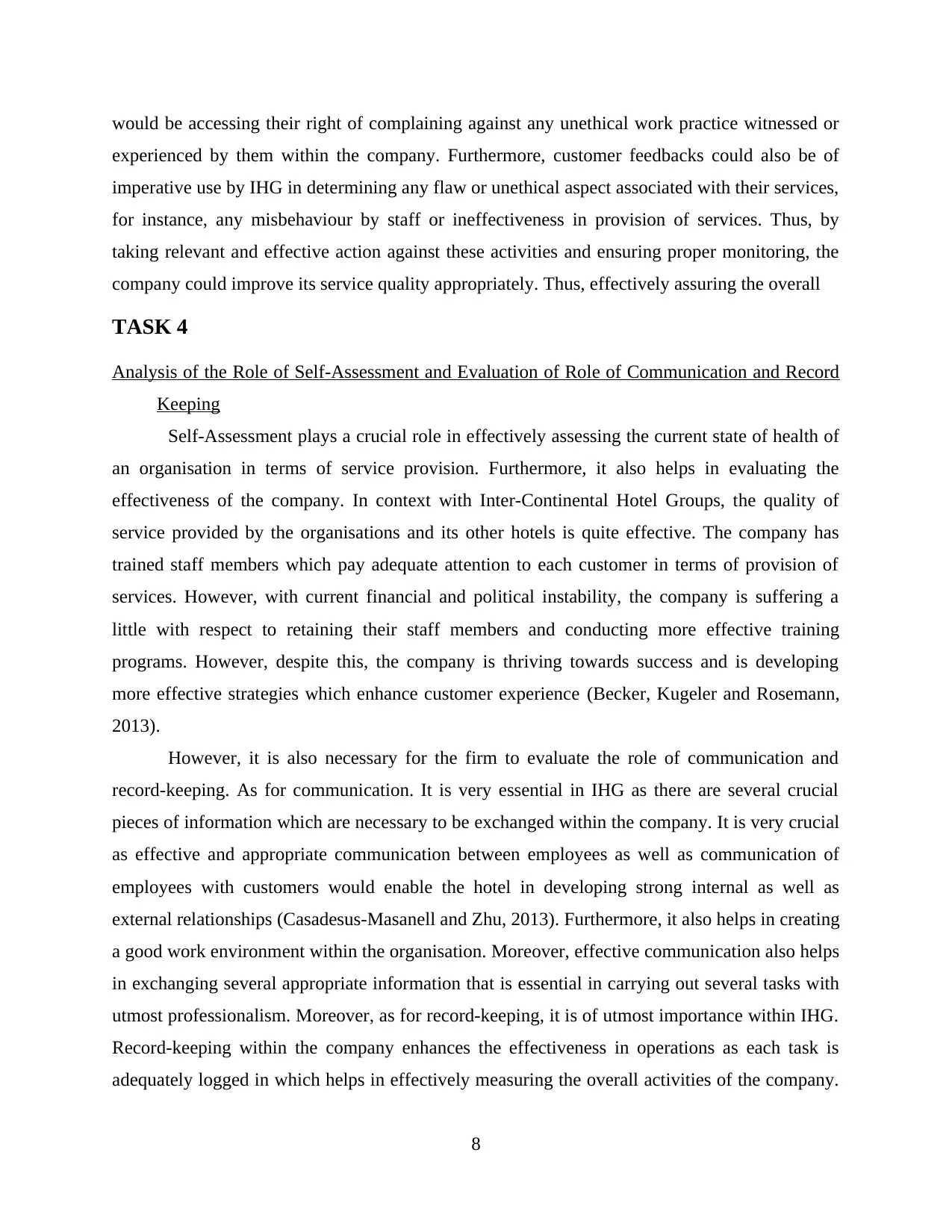
would be accessing their right of complaining against any unethical work practice witnessed or
experienced by them within the company. Furthermore, customer feedbacks could also be of
imperative use by IHG in determining any flaw or unethical aspect associated with their services,
for instance, any misbehaviour by staff or ineffectiveness in provision of services. Thus, by
taking relevant and effective action against these activities and ensuring proper monitoring, the
company could improve its service quality appropriately. Thus, effectively assuring the overall
TASK 4
Analysis of the Role of Self-Assessment and Evaluation of Role of Communication and Record
Keeping
Self-Assessment plays a crucial role in effectively assessing the current state of health of
an organisation in terms of service provision. Furthermore, it also helps in evaluating the
effectiveness of the company. In context with Inter-Continental Hotel Groups, the quality of
service provided by the organisations and its other hotels is quite effective. The company has
trained staff members which pay adequate attention to each customer in terms of provision of
services. However, with current financial and political instability, the company is suffering a
little with respect to retaining their staff members and conducting more effective training
programs. However, despite this, the company is thriving towards success and is developing
more effective strategies which enhance customer experience (Becker, Kugeler and Rosemann,
2013).
However, it is also necessary for the firm to evaluate the role of communication and
record-keeping. As for communication. It is very essential in IHG as there are several crucial
pieces of information which are necessary to be exchanged within the company. It is very crucial
as effective and appropriate communication between employees as well as communication of
employees with customers would enable the hotel in developing strong internal as well as
external relationships (Casadesus‐Masanell and Zhu, 2013). Furthermore, it also helps in creating
a good work environment within the organisation. Moreover, effective communication also helps
in exchanging several appropriate information that is essential in carrying out several tasks with
utmost professionalism. Moreover, as for record-keeping, it is of utmost importance within IHG.
Record-keeping within the company enhances the effectiveness in operations as each task is
adequately logged in which helps in effectively measuring the overall activities of the company.
8
experienced by them within the company. Furthermore, customer feedbacks could also be of
imperative use by IHG in determining any flaw or unethical aspect associated with their services,
for instance, any misbehaviour by staff or ineffectiveness in provision of services. Thus, by
taking relevant and effective action against these activities and ensuring proper monitoring, the
company could improve its service quality appropriately. Thus, effectively assuring the overall
TASK 4
Analysis of the Role of Self-Assessment and Evaluation of Role of Communication and Record
Keeping
Self-Assessment plays a crucial role in effectively assessing the current state of health of
an organisation in terms of service provision. Furthermore, it also helps in evaluating the
effectiveness of the company. In context with Inter-Continental Hotel Groups, the quality of
service provided by the organisations and its other hotels is quite effective. The company has
trained staff members which pay adequate attention to each customer in terms of provision of
services. However, with current financial and political instability, the company is suffering a
little with respect to retaining their staff members and conducting more effective training
programs. However, despite this, the company is thriving towards success and is developing
more effective strategies which enhance customer experience (Becker, Kugeler and Rosemann,
2013).
However, it is also necessary for the firm to evaluate the role of communication and
record-keeping. As for communication. It is very essential in IHG as there are several crucial
pieces of information which are necessary to be exchanged within the company. It is very crucial
as effective and appropriate communication between employees as well as communication of
employees with customers would enable the hotel in developing strong internal as well as
external relationships (Casadesus‐Masanell and Zhu, 2013). Furthermore, it also helps in creating
a good work environment within the organisation. Moreover, effective communication also helps
in exchanging several appropriate information that is essential in carrying out several tasks with
utmost professionalism. Moreover, as for record-keeping, it is of utmost importance within IHG.
Record-keeping within the company enhances the effectiveness in operations as each task is
adequately logged in which helps in effectively measuring the overall activities of the company.
8
Paraphrase This Document
Need a fresh take? Get an instant paraphrase of this document with our AI Paraphraser
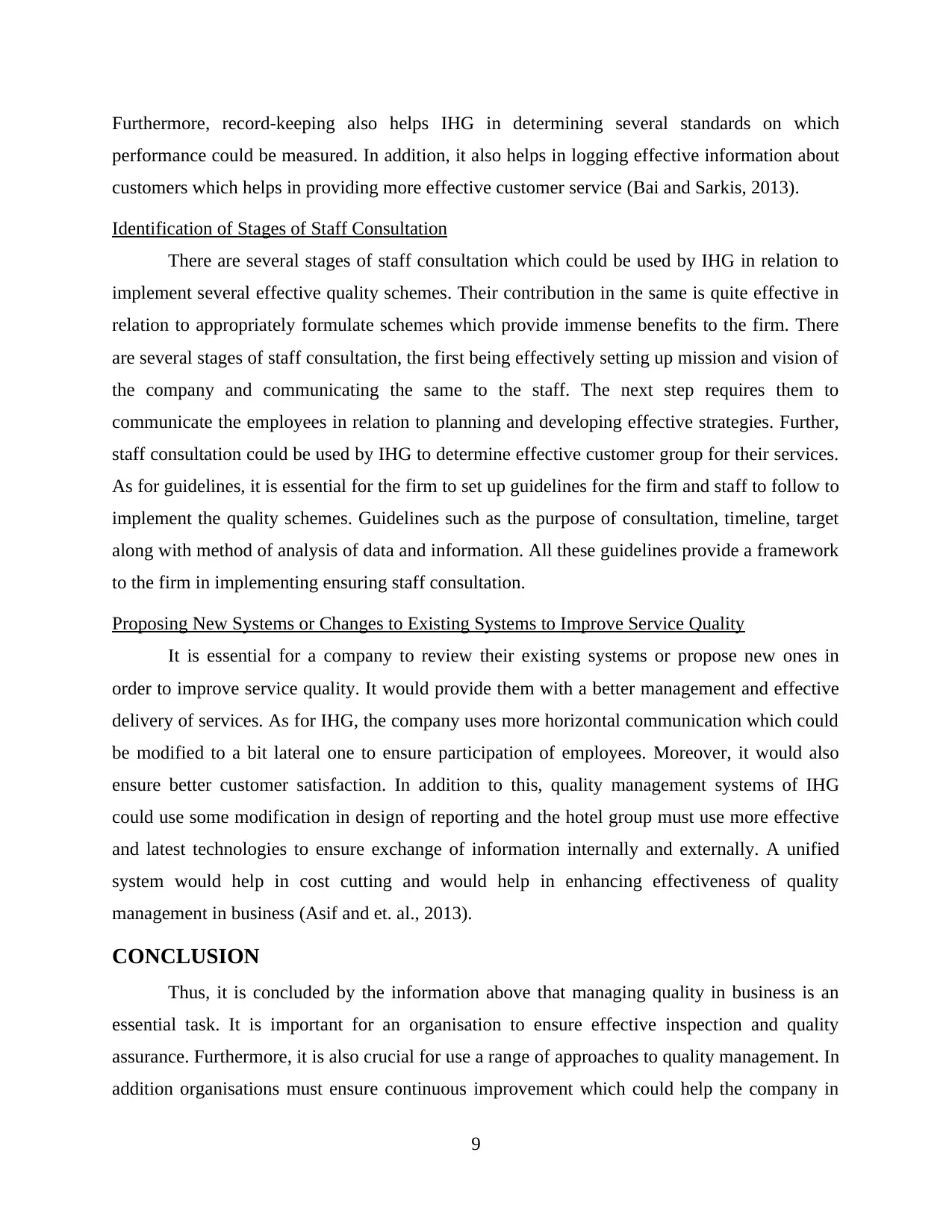
Furthermore, record-keeping also helps IHG in determining several standards on which
performance could be measured. In addition, it also helps in logging effective information about
customers which helps in providing more effective customer service (Bai and Sarkis, 2013).
Identification of Stages of Staff Consultation
There are several stages of staff consultation which could be used by IHG in relation to
implement several effective quality schemes. Their contribution in the same is quite effective in
relation to appropriately formulate schemes which provide immense benefits to the firm. There
are several stages of staff consultation, the first being effectively setting up mission and vision of
the company and communicating the same to the staff. The next step requires them to
communicate the employees in relation to planning and developing effective strategies. Further,
staff consultation could be used by IHG to determine effective customer group for their services.
As for guidelines, it is essential for the firm to set up guidelines for the firm and staff to follow to
implement the quality schemes. Guidelines such as the purpose of consultation, timeline, target
along with method of analysis of data and information. All these guidelines provide a framework
to the firm in implementing ensuring staff consultation.
Proposing New Systems or Changes to Existing Systems to Improve Service Quality
It is essential for a company to review their existing systems or propose new ones in
order to improve service quality. It would provide them with a better management and effective
delivery of services. As for IHG, the company uses more horizontal communication which could
be modified to a bit lateral one to ensure participation of employees. Moreover, it would also
ensure better customer satisfaction. In addition to this, quality management systems of IHG
could use some modification in design of reporting and the hotel group must use more effective
and latest technologies to ensure exchange of information internally and externally. A unified
system would help in cost cutting and would help in enhancing effectiveness of quality
management in business (Asif and et. al., 2013).
CONCLUSION
Thus, it is concluded by the information above that managing quality in business is an
essential task. It is important for an organisation to ensure effective inspection and quality
assurance. Furthermore, it is also crucial for use a range of approaches to quality management. In
addition organisations must ensure continuous improvement which could help the company in
9
performance could be measured. In addition, it also helps in logging effective information about
customers which helps in providing more effective customer service (Bai and Sarkis, 2013).
Identification of Stages of Staff Consultation
There are several stages of staff consultation which could be used by IHG in relation to
implement several effective quality schemes. Their contribution in the same is quite effective in
relation to appropriately formulate schemes which provide immense benefits to the firm. There
are several stages of staff consultation, the first being effectively setting up mission and vision of
the company and communicating the same to the staff. The next step requires them to
communicate the employees in relation to planning and developing effective strategies. Further,
staff consultation could be used by IHG to determine effective customer group for their services.
As for guidelines, it is essential for the firm to set up guidelines for the firm and staff to follow to
implement the quality schemes. Guidelines such as the purpose of consultation, timeline, target
along with method of analysis of data and information. All these guidelines provide a framework
to the firm in implementing ensuring staff consultation.
Proposing New Systems or Changes to Existing Systems to Improve Service Quality
It is essential for a company to review their existing systems or propose new ones in
order to improve service quality. It would provide them with a better management and effective
delivery of services. As for IHG, the company uses more horizontal communication which could
be modified to a bit lateral one to ensure participation of employees. Moreover, it would also
ensure better customer satisfaction. In addition to this, quality management systems of IHG
could use some modification in design of reporting and the hotel group must use more effective
and latest technologies to ensure exchange of information internally and externally. A unified
system would help in cost cutting and would help in enhancing effectiveness of quality
management in business (Asif and et. al., 2013).
CONCLUSION
Thus, it is concluded by the information above that managing quality in business is an
essential task. It is important for an organisation to ensure effective inspection and quality
assurance. Furthermore, it is also crucial for use a range of approaches to quality management. In
addition organisations must ensure continuous improvement which could help the company in
9
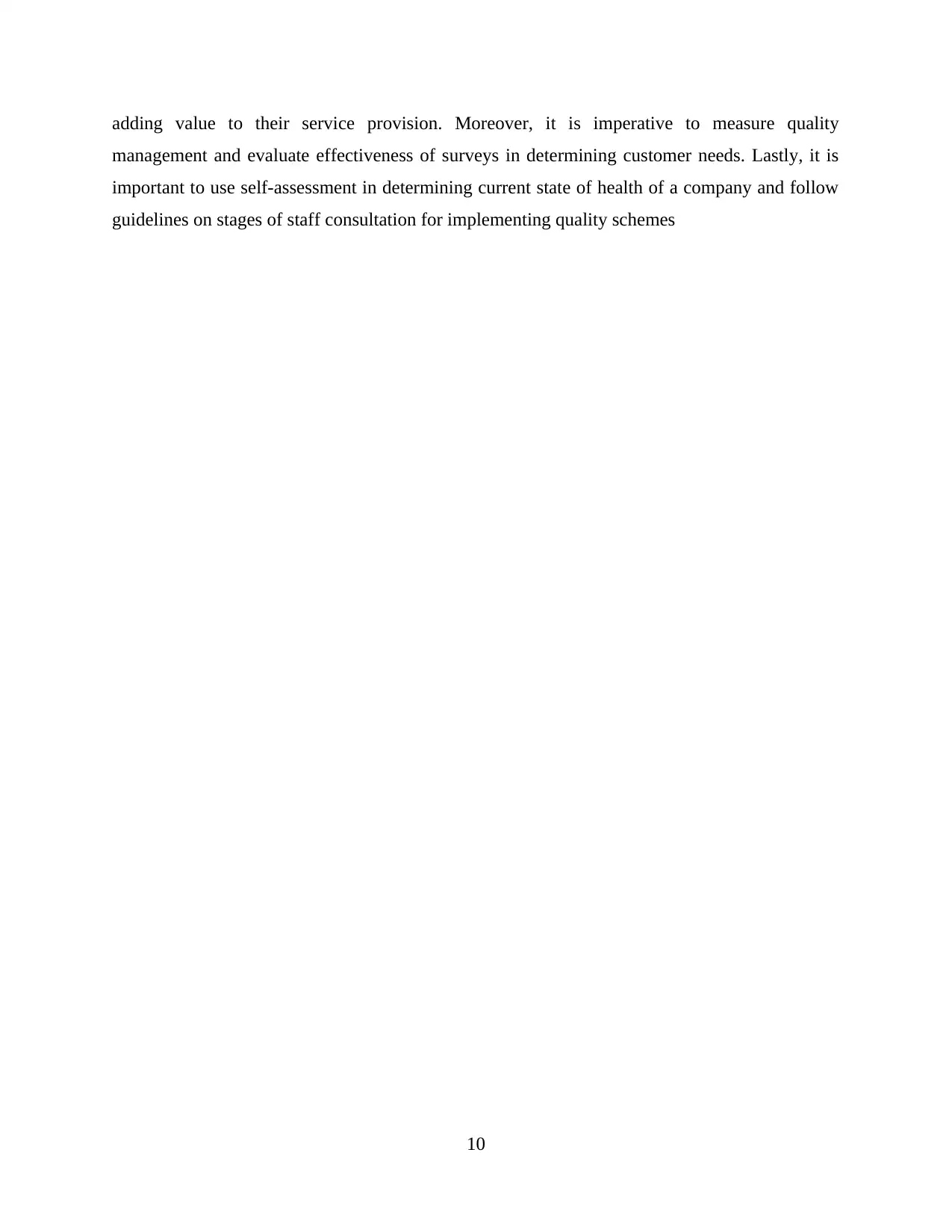
adding value to their service provision. Moreover, it is imperative to measure quality
management and evaluate effectiveness of surveys in determining customer needs. Lastly, it is
important to use self-assessment in determining current state of health of a company and follow
guidelines on stages of staff consultation for implementing quality schemes
10
management and evaluate effectiveness of surveys in determining customer needs. Lastly, it is
important to use self-assessment in determining current state of health of a company and follow
guidelines on stages of staff consultation for implementing quality schemes
10
⊘ This is a preview!⊘
Do you want full access?
Subscribe today to unlock all pages.

Trusted by 1+ million students worldwide
1 out of 13
Related Documents
Your All-in-One AI-Powered Toolkit for Academic Success.
+13062052269
info@desklib.com
Available 24*7 on WhatsApp / Email
![[object Object]](/_next/static/media/star-bottom.7253800d.svg)
Unlock your academic potential
Copyright © 2020–2025 A2Z Services. All Rights Reserved. Developed and managed by ZUCOL.





